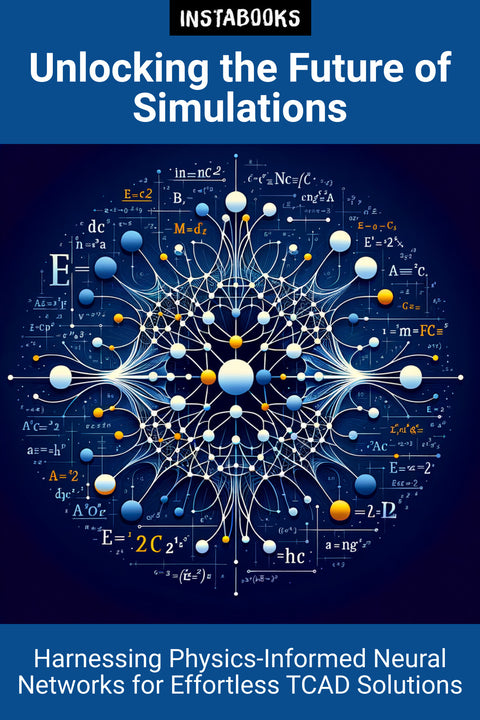
Unlocking the Future of Simulations
Harnessing Physics-Informed Neural Networks for Effortless TCAD Solutions
Included:
✓ 200+ Page AI-Generated Book
✓ ePub eBook File — read on Kindle & Apple Books
✓ PDF Print File (Easy Printing)
✓ Word DOCX File (Easy Editing)
✓ Hi-Res Print-Ready Book Cover (No Logo Watermark)
✓ Full Commercial Use Rights — keep 100% of royalties
✓ Publish under your own Author Name
✓ Sell on Amazon KDP, IngramSpark, Lulu, Blurb & Gumroad to millions of readers worldwide
Introduction
Dive into the cutting-edge world of Physics-Informed Neural Networks (PINNs) and discover how they are revolutionizing Technology Computer-Aided Design (TCAD) simulations. This book is tailor-made for anyone eager to navigate the complexities of predicting out-of-training-range solutions with ease and minimal domain expertise. Unlock the secrets of integrating physical knowledge into neural network training and see how this technique can expand your predictions far beyond traditional capabilities.
Exploring Key Concepts
Start your journey by understanding the core aspects of PINNs. Learn what sets these neural networks apart and how their ability to incorporate physical laws into their architecture results in unparalleled advantages. From predicting solutions beyond existing data ranges to handling sparse and noisy datasets, PINNs elevate your computational simulations to new heights.
Overcoming Traditional TCAD Challenges
Delve into the common hurdles faced in TCAD simulations. See how traditional machine learning models often fall short, requiring significant domain expertise and access to internal solvers. Explore how PINNs break these barriers, offering a path to out-of-training-range predictions with reduced reliance on domain-specific knowledge.
The Magic Behind the Training Process
Uncover the intricacies of training PINNs. From employing physics-based loss functions that enhance model precision to designing architectures that honor boundary conditions, this book guides you through building robust models. The shift to a physics-based approach promises a leap in generalization capabilities, transforming the way simulations predict physical behaviors.
Applications and Real-World Examples
Explore fascinating case studies, including a Si nanowire example that showcases PINNs' ability to vastly exceed traditional methods in prediction range. Such real-world applications highlight the potential of PINNs in modeling semiconductor devices, fluid flow, and beyond, offering unprecedented insight into complex systems.
Conclude with Visionary Insights
Conclude your exploration with a renewed understanding of how PINNs are setting a new standard in TCAD simulations. By bridging the gap between machine learning and physical laws, these networks offer powerful tools for engineers and researchers looking to innovate with fewer constraints. This book serves not just as a guide, but as an inspiration for future innovations in simulation technologies.
Table of Contents
1. Introduction to PINNs- Understanding PINNs
- Benefits Over Traditional Models
- Core Components of PINNs
2. Decoding TCAD Simulations
- Challenges in Traditional Methods
- Role of PINNs
- Future Prospects
3. Training Neural Networks with Physics
- Inductive Bias in Training
- Designing Physics-Based Loss Functions
- Ensuring Compliance with Physical Laws
4. Breaking the Expertise Barrier
- Minimizing Domain Expertise Needs
- User-Friendly Solutions
- Expanding Reach
5. Case Study: Si Nanowire Innovation
- Overview of the Study
- Outperforming Traditional Methods
- Lessons Learned
6. Architectural Choices in PINNs
- Balancing Complexity and Simplicity
- Incorporating Boundary Conditions
- Optimizing for Performance
7. Applications Across Industries
- Semiconductor Devices
- Fluid Dynamics
- Beyond Predictive Modeling
8. Harnessing Statistical Physics
- Foundation in Statistical Mechanics
- Functional Properties of PINNs
- Integration with ML Techniques
9. Generalization beyond Data
- Predicting Uncharted Territories
- Handling Sparse Data
- Expanding Model Capabilities
10. Implementing PINNs in Real-World
- Practical Steps for Engineers
- Tools and Platforms
- Learning from Real-World Cases
11. Understanding the Limitations
- Current Challenges
- Overcoming Hurdles
- Future Research Directions
12. Embracing the Future of Simulation
- Visions for Tomorrow
- Role in Innovation
- Inspirations for Engineers
Target Audience
This book is designed for engineers, researchers, and data scientists interested in leveraging Physics-Informed Neural Networks for advanced TCAD simulations with minimal domain expertise.
Key Takeaways
- Understand the unique advantages of Physics-Informed Neural Networks in TCAD simulations.
- Learn how to overcome traditional simulation challenges without extensive domain expertise.
- Explore real-world applications and case studies highlighting PINNs' effectiveness.
- Gain insights into training neural networks with physics-based loss functions.
- Discover future prospects and inspirational insights for leveraging PINNs.
